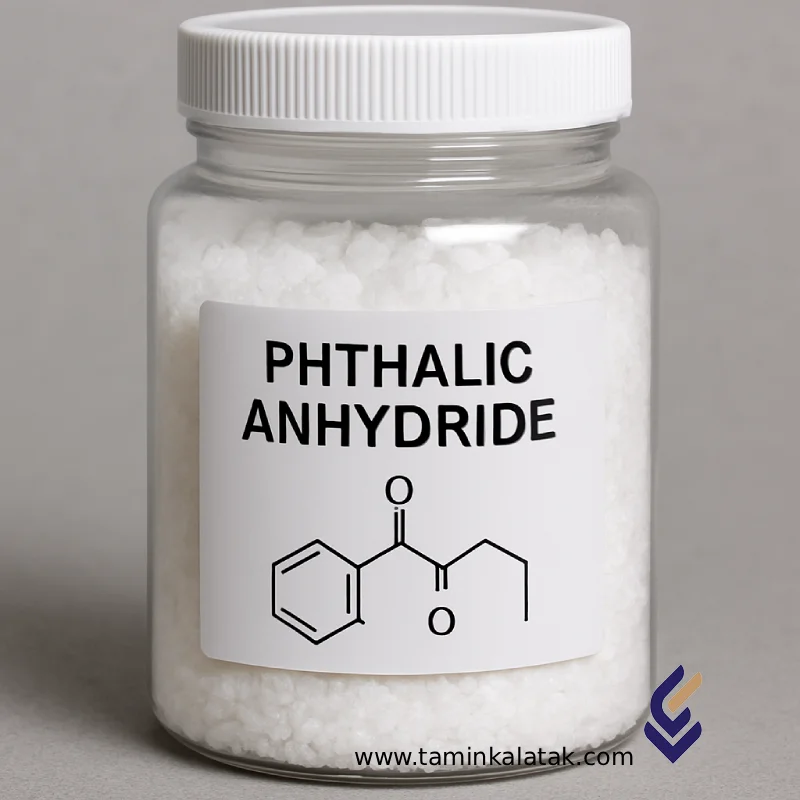Phthalic anhydride
Phthalic Anhydride is an important aromatic chemical intermediate that appears as white crystalline flakes or powder with a pungent, irritating odor.
It is primarily used as a key raw material in the production of saturated and unsaturated polyester resins, PVC plasticizers, alkyd resins, and various pharmaceutical and dye intermediates.
Chemical Structure
Phthalic Anhydride consists of a 1,3-isobenzofuran-1,3-dione ring, obtained by dehydration of phthalic acid.
-
Molecular Formula: C₈H₄O₃
-
Structure Type: Cyclic anhydride derived from phthalic acid
-
Functional Groups: Two carbonyl groups within a fused aromatic ring
Physical and Chemical Properties
| Property | Specification |
|---|---|
| Appearance | White to transparent crystalline solid or powder |
| Density (solid, 20 °C) | ~1.53 g/cm³ |
| Melting Point | 131–132 °C |
| Boiling Point | 284–295 °C (may sublime) |
| Vapor Pressure (20 °C) | ~0.0015 mmHg (very low) |
| Solubility in Water | Slight (~0.62 g/100 g at 20 °C); higher at 100 °C (~19 g/100 g) |
| Color and Odor | Colorless to faint yellow; strong, pungent odor |
Key Advantages
-
Essential intermediate in manufacturing saturated and unsaturated polyester resins, widely used in fiberglass, coatings, and industrial paints.
-
Primary precursor for phthalate plasticizers used to enhance flexibility and durability in PVC.
-
Plays a crucial role in the synthesis of pharmaceuticals, dyes, pigments, and cosmetic raw materials.
-
High reactivity and conversion efficiency, enabling cost-effective large-scale production.
Limitations and Hazards
-
Strong irritant to skin, eyes, and respiratory system; requires controlled industrial environments.
-
Dust explosion hazard: airborne fine particles may ignite — appropriate dust control systems are essential.
-
Reacts exothermically with moisture — hydrolyzes to phthalic acid upon exposure to humidity.
-
Environmental restrictions apply in some regions due to ecological impact and emission control standards.
Applications
-
Unsaturated Polyester Resins (UPR): for FRP, composites, laminates, and industrial coatings.
-
Plasticizer Production: synthesis of phthalate esters for flexible PVC applications.
-
Paints, Adhesives, and Pigments: intermediate for alkyd resins and colorant synthesis.
-
Pharmaceuticals and Cosmetics: used in controlled synthesis of active intermediates.
-
Specialty Chemicals: manufacturing of lubricant additives, fertilizers, and functionalized industrial oils.
Safety and Handling
GHS Classification:
-
H317 – May cause an allergic skin reaction
-
H318 – Causes serious eye damage
-
H334 – May cause respiratory sensitization
Personal Protective Equipment (PPE):
-
Safety goggles or face shield
-
Chemical-resistant gloves and protective clothing
-
Respiratory protection where dust formation is possible
Storage Conditions:
-
Store in a cool, dry, and well-ventilated area
-
Keep containers tightly closed and away from moisture
-
Prevent dust accumulation and static discharge
Emergency Measures:
-
Skin/Eye Contact: Flush immediately with plenty of water and seek medical attention
-
Inhalation: Move to fresh air and consult a physician if irritation persists
-
Spillage: Avoid dust dispersion; collect dry material and dispose of safely according to local regulations
Summary:
Phthalic Anhydride (PA) is a high-purity, versatile intermediate essential in the resin, plasticizer, coating, and chemical manufacturing industries.
Its balance of reactivity, performance, and product yield makes it a critical compound in modern industrial chemistry — provided it is handled under proper safety and environmental protocols.
Applications
| Applications | , , |
|---|
Phthalic anhydride
| Products | Grade | Vapor pressure | Physical appearance | Density (at 20°C) | Solubility in water | Melting point | CAS number | Chemical formula |
|---|---|---|---|---|---|---|---|---|
| Maleic Anhydride | Industrial, laboratory, pharmaceutical | ~0.16 mmHg | White to colorless solid, crystal or powder with a pungent, irritating odor. | ~1.48 g/cm³ | ~79 g/L at 25 °C (by hydrolysis to maleic acid) | 52–56 °C | 108-31-6 | C₄H₂O₃ |







